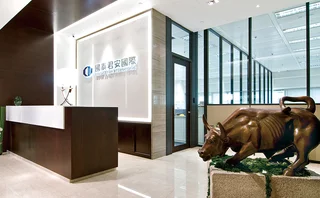
Riding the wave
Healthy returns on emerging market names, in part boosted by improvements in credit quality, have attracted many investors who previously considered the sector a no-go area. But the party may not last for much longer, as Saskia Scholtes reports

According to the Institute of International Finance, in 2003 net non-bank private sector lending to emerging markets, mostly in the form of bonds, hit a five-year high of $45 billion. However, analysts warn that in the coming months, emerging markets may find that they are no longer the asset class of choice.
At year-end 2003, the JP Morgan emerging market credit index had returned 29%, with spreads tightening 341bp to 424bp over US Treasuries, their narrowest level in six years. Such a dramatic market movement is made all the more impressive by the fact that emerging market bond issuance in 2003 was up over 50% relative to the 2001–2002 average.
Credit quality
Among the factors contributing to the rally is marked progress in emerging market creditworthiness. Last year saw more sovereign ratings upgrades than in any year since 1995, with Russia becoming the second major emerging market after Mexico to obtain investment-grade status from a credit rating agency. Across all emerging market bonds, credit quality struck an upbeat note in 2003. Rating agency Standard & Poor’s recorded 62 upgrades against 57 downgrades, the lowest downgrade ratio since 1996.
One particular success story is Brazil. Spreads for Brazilian bonds have tightened by nearly 2,300bp from their peak in September 2002, as the new president Luiz Inácio Lula da Silva has alleviated concerns about Brazil’s external financing needs, working to bring stability to the country’s exchange rate and reduce inflation. Total returns on Brazilian bonds from October 2002 to the end of last year were an incredible 124%.
Like several other emerging market economies in 2003, Brazil also benefited from external economic factors. For one, the beginnings of recovery in the US contributed to a strengthening world economy. And as Mohamed El-Erian, emerging markets research analyst at fund manager Pimco, says, “It helps having several members of the asset class that are important exporters of raw materials—they benefited enormously last year from the surge in international commodity prices.”
However, analysts agree that the defining theme of 2003’s emerging markets rally was the strong technical environment. “Record low interest rates fuelled appetite for credit product,” says Joyce Chang, head of emerging markets research at JPMorgan. “This contributed to record inflows into the asset class from all segments of the investor base, at the same time that allocations away from equities into fixed income fuelled the rally.”
Chang points out that the sector has seen a growth in crossover investment from funds not traditionally accustomed to thinking of emerging markets as a suitable proposition. As credit quality in emerging market economies has continued to improve, the pool of potential investors has grown since many mutual funds, pension funds and insurers are barred from buying non-investment grade paper.
Officials in developing countries are naturally eager to make the most of this newfound enthusiasm, and have ridden the positive sentiment to front-load their countries’ 2004 borrowing programs. According to data from Thomson Financial, January saw bond issuance in emerging markets of $13.7 billion, the highest monthly figure in six years. Mexico, Turkey, Poland, Brazil, Hungary and Venezuela all issued more than $1 billion of foreign currency bonds and analysts predict that more is on the way.
On the downside
However, while a confluence of positive factors produced good news for emerging markets last year, many analysts argue that valuations are now quite high. Any additional upside is limited and the asset class is set to experience increasing downside risk as we move further into 2004.
At the local level, while the fundamentals are undoubtedly improving, emerging markets policy-makers will need to be wary of embarking on overambitious financing strategies. El-Erian at Pimco points to a comment made by one finance official a few years ago, that it is “harder to manage success than to manage a crisis”. As El-Erian explains, policy-makers can lose focus in the face of success, “inadvisably substituting a sprint for the necessary marathon that best characterizes the process of economic development”.
JPMorgan’s Chang says, “Politics has often derailed emerging markets performance in the past and the political calendar remains heavy this year, with elections scheduled in the Philippines, Malaysia, South Korea, Dominican Republic, Uruguay, Indonesia, Russia and possibly Venezuela.” While Chang explains that electoral volatility may in fact represent opportunities for most countries, investors should watch for event risk in certain hotspots, including Indonesia, Algeria, Dominican Republic, Lebanon and Ukraine.
At the international level, acceleration of economic activity in the US and Asia and a likely pickup in European growth means that the world economy is moving toward the point when interest rates in the main financial centers will begin to increase. In the past few months, yields on government bonds have begun to rise in Europe, Japan and the US, and the Bank of England has raised interest rates twice since early November 2003. Now the debate is focused on exactly when and by how much the Federal Reserve and the other leading central banks will allow interest rates to rise in the coming year.
From the perspective of investors in emerging markets, rising interest rates in the euro, dollar and sterling markets are not ideal for positive returns. As James Sha, emerging markets analyst at ABN Amro, says, “The very tight spread levels seen in most emerging markets credits suggest that the asset class has little cushion to absorb the impact of rising interest rates, not to mention the negative effect of rising funding costs that come with higher rates.”
This, together with the implications of mounting US fiscal and current account deficits, the fate of the US dollar against the euro and yen and the potential revaluation of China’s currency against the dollar, is contributing to fears that investors may be scared out of emerging markets in the months to come.
However Filippo Nencioni, head of emerging markets strategy at Credit Suisse First Boston, says, “We do not believe an increase in rates would ignite an emerging markets bear market: these are normally triggered by endogenous crises in large countries.”
He explains that after an initial knee-jerk reaction, the impact of a rate hike would be mitigated by a few factors: for one, emerging markets are reducing their reliance on external capital markets; second, average rates for the year would still be historically low; and third, an eventual increase would hardly be a surprise to the market.
So while the downside risk for emerging markets in 2004 is undoubtedly mounting, it seems that the market is preparing for it. And despite some opportunistic crossover investment in emerging markets in the past year, analysts argue that much of the new inflow into the market was strategic in nature and unlikely to reverse easily or rapidly. The onus now rests with officials in the emerging markets economies to continue delivering the kind of progress which investors have become accustomed to.
Only users who have a paid subscription or are part of a corporate subscription are able to print or copy content.
To access these options, along with all other subscription benefits, please contact info@risk.net or view our subscription options here: http://subscriptions.risk.net/subscribe
You are currently unable to print this content. Please contact info@risk.net to find out more.
You are currently unable to copy this content. Please contact info@risk.net to find out more.
Copyright Infopro Digital Limited. All rights reserved.
You may share this content using our article tools. Printing this content is for the sole use of the Authorised User (named subscriber), as outlined in our terms and conditions - https://www.infopro-insight.com/terms-conditions/insight-subscriptions/
If you would like to purchase additional rights please email info@risk.net
Copyright Infopro Digital Limited. All rights reserved.
You may share this content using our article tools. Copying this content is for the sole use of the Authorised User (named subscriber), as outlined in our terms and conditions - https://www.infopro-insight.com/terms-conditions/insight-subscriptions/
If you would like to purchase additional rights please email info@risk.net
More on Structured products
A guide to home equity investments: the untapped real estate asset class
This report covers the investment opportunity in untapped home equity and the growth of HEIs, and outlines why the current macroeconomic environment presents a unique inflection point for credit-oriented investors to invest in HEIs
Podcast: Claudio Albanese on how bad models survive
Darwin’s theory of natural selection could help quants detect flawed models and strategies
Range accruals under spotlight as Taiwan prepares for FRTB
Taiwanese banks review viability of products offering options on long-dated rates
Structured products gain favour among Chinese enterprises
The Chinese government’s flagship national strategy for the advancement of regional connectivity – the Belt and Road Initiative – continues to encourage the outward expansion of Chinese state-owned enterprises (SOEs). Here, Guotai Junan International…
Structured notes – Transforming risk into opportunities
Global markets have experienced a period of extreme volatility in response to acute concerns over the economic impact of the Covid‑19 pandemic. Numerix explores what this means for traders, issuers, risk managers and investors as the structured products…
Structured products – Transforming risk into opportunities
The structured product market is one of the most dynamic and complex of all, offering a multitude of benefits to investors. But increased regulation, intense competition and heightened volatility have become the new normal in financial markets, creating…
Increased adoption and innovation are driving the structured products market
To help better understand the challenges and opportunities a range of firms face when operating in this business, the current trends and future of structured products, and how the digital evolution is impacting the market, Numerix’s Ilja Faerman, senior…
Structured products – The ART of risk transfer
Exploring the risk thrown up by autocallables has created a new family of structured products, offering diversification to investors while allowing their manufacturers room to extend their portfolios, writes Manvir Nijhar, co-head of equities and equity…







